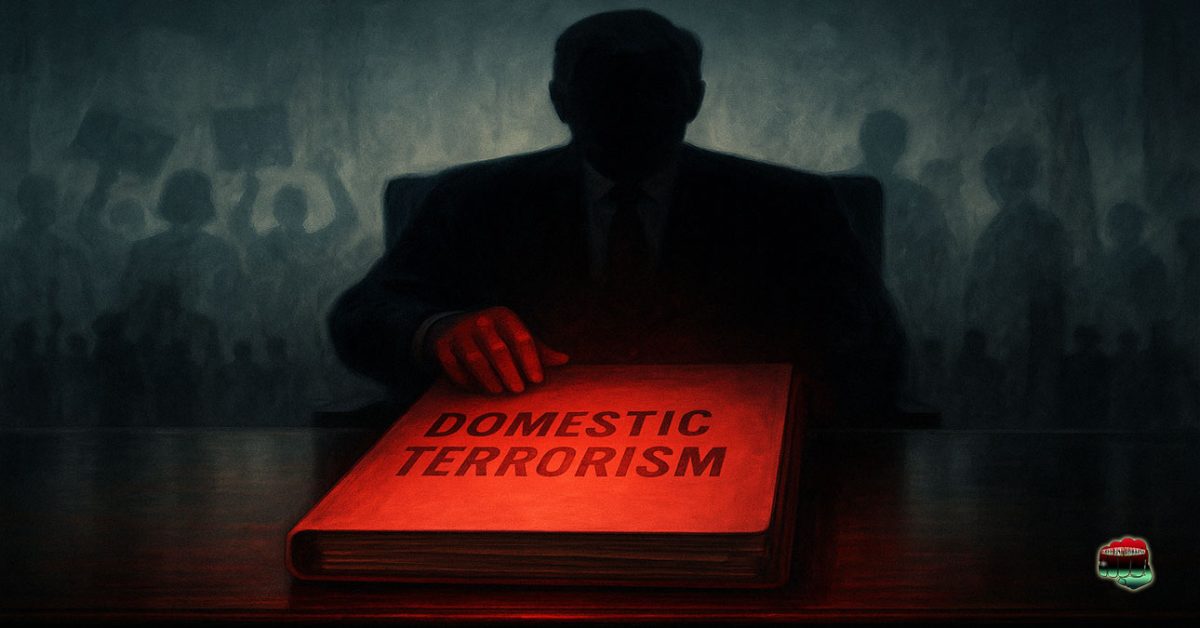By InnerKwest Global Editorial Board | October 9, 2025
A New Mandate Cloaked in Security
On September 25, President Donald J. Trump signed a memorandum titled “Countering Domestic Terrorism and Organized Political Violence.” At first glance, it reads like a shield against extremists. But peel back the legal language, and the silhouette changes. What emerges is less about protecting Americans from violence and more about protecting one man’s political power through intimidation and suspicion.
The White House declares that the FBI’s Joint Terrorism Task Forces, the Department of Justice, and the IRS will “investigate, disrupt, and dismantle” organizations linked to political violence. Yet the memorandum’s definitions stretch so wide they risk ensnaring not only extremists, but protestors, nonprofits, even critics exercising their constitutional rights.
This is not just policy. It is power dressed in the language of protection.
Vagueness: The First Red Flag
The memorandum’s definitions are disturbingly broad. “Political violence” is stretched to include intimidation, radicalization, and civil disorder. Those words are elastic, bendable to fit whatever shape the administration needs.
- A protest outside a courthouse—terrorism?
- A nonprofit funding a march—“indirect support”?
- A critical voice online—“radicalization”?
The danger here isn’t in what’s written. It’s in what can be read into it. Fear takes root not when laws are clear, but when they are limitless.
A Weapon Pointed Inward
By directing agencies to go after “funders, officers, and employees” of suspect groups, the memorandum points its barrel inward—at civil society itself.
This isn’t about isolated extremists. It’s about creating an expandable net. A net that can entangle foundations, churches, advocacy groups, and individuals whose only “crime” is opposition.
The chilling part? The net doesn’t just catch enemies. It warns everyone else watching: Stay quiet, or you could be next.
Ramifications Beyond the Headlines
The consequences ripple outward:
- Civil Society Under Siege – Advocacy nonprofits risk losing status, funding, and credibility.
- Political Enemies List 2.0 – Past and present critics can be dragged into investigations under the banner of “domestic terrorism.”
- Future Precedent – Any president, left or right, could inherit this machinery and use it to silence their own adversaries.
The question isn’t whether this power will be used. It’s who it will be used against first—and who it will silence after.
The Mentality Behind Disruption
What kind of mind spends its life plotting to harm, disrupt, and dismantle the lives of others? Life is uncertain enough without individuals—or governments—dedicating their energy to sowing chaos. Is their own existence so miserable, so disfigured, that they feel compelled to share their disdain with the world?
This is the paradox of destructive power: misery seeks company. Instead of healing fractures, some project them outward, dragging others into their pit. For some, ideology provides a mask—whether political or religious—offering cover for what is, at root, bitterness and despair. Destruction becomes a false form of control, a shortcut to power.
The September 25 memorandum reflects that same impulse on a national scale. Rather than strengthening democracy by affirming rights and building resilience, it leans toward disruption—casting suspicion on nonprofits, advocates, and dissenters, and threatening to dismantle the civic trust that makes democracy possible.
History’s Echo: The George Wallace Arc
This same contrary position once resided in the vessel named George Wallace—the Alabama governor who built a career on obstruction and defiance, choosing disruption as his weapon against civil rights. He embodied the politics of harm, elevating division as policy.
Yet later in life, Wallace asked for forgiveness. His story shows that destructive impulses, however fierce, are not immutable. They spring from fear, insecurity, and self-loathing masquerading as strength. Wallace’s eventual admission is a sobering reminder: those who wield disruption in the name of power often end in regret, recognizing too late the damage they caused.
The question before us now is whether Trump’s memorandum will be remembered as another Wallace moment—an attempt to hold back the tide by punishing dissent—or whether the nation will resist before history repeats itself.
The Constitutional Collision
The First Amendment was built to protect dissent, especially the inconvenient, the unpopular, and the uncomfortable. When government blurs the line between “security” and “silencing,” the Constitution doesn’t bend—it breaks.
We’ve seen this before:
- McCarthy’s loyalty oaths.
- COINTELPRO’s surveillance of civil rights leaders.
- The Patriot Act’s watchlists.
Each time, fear opened the door wider than liberty could handle. Each time, democracy was left weaker.
Our Closing Argument
The September 25 memorandum is not a shield—it’s a signal. A test to see how far executive power can reach without resistance.
Its vagueness is deliberate. Its timing, strategic. Its intent? To make the public hesitate before speaking, to force organizations to calculate the risk of dissent. That hesitation—that calculation—is the real violence.
If Americans accept this order as ordinary, tomorrow’s definition of “terrorism” could be a protest chant, a sermon, a headline, or even an editorial like this one.
Forgiveness may come to individuals like George Wallace, but when government enshrines this mentality into policy, the consequences are collective and enduring. If left unchallenged, this memorandum risks making misery a governing philosophy.
This is not only about Trump. It is about the architecture of fear he is constructing—and whether the public will accept it as permanent scaffolding.
👉 Editorial Note: InnerKwest will continue to monitor how this memorandum is enforced, who it targets, and whether the courts or Congress step in. The political ramifications are not hypothetical—they are already unfolding in the crosshairs of power.
Support InnerKwest: Powering Truth & Excellence with Bitcoin
At InnerKwest.com, we are committed to delivering impactful journalism, deep insights, and fearless social commentary. Your Bitcoin contributions help us execute with excellence, ensuring we remain independent and continue to amplify voices that matter.
Support our mission—send BTC today!
🔗 Bitcoin Address: 3NM7AAdxxaJ7jUhZ2nyfgcheWkrquvCzRm
Thank you for standing with us in pursuit of truth and progress!![]()

